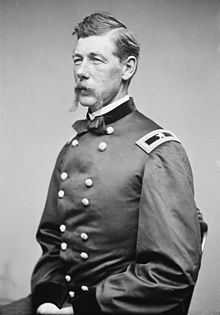Alexander Shaler
Alexander Shaler | |
|---|---|
 Alexander Shaler | |
| Born | March 19, 1827 Haddam, Connecticut |
| Died | December 28, 1911 (aged 84) New York City |
| Place of burial | Ridgefield Cemetery, Ridgefield, New Jersey |
| Allegiance | United States Union |
| Service/ | United States Army Union Army |
| Years of service | 1861–1865 |
| Rank | |
| Battles/wars | American Civil War |
Alexander Shaler (March 19, 1827 – December 28, 1911) was a
Early life
Shaler was born in
American Civil War: Service in the East
After returning to New York City, Shaler became
Shaler assumed command of the brigade in March 1863 following the resignation of
In the Battle of Gettysburg, VI Corps served as a reserve for the Army of the Potomac. Shaler's brigade was sent to the right flank early on July 3, 1863. There it helped XII Corps hold Culp's Hill. Shaler's brigade usually was in reserve, but units went to the front line to help in resisting Confederate attacks. About 3:30 that afternoon, Shaler's brigade was sent to the center of the army as a reserve around the time of the repulse of Pickett's Charge.[5]
Shaler commanded the prisoner of war camp at
American Civil War: Service in the West
After being exchanged, Shaler was transferred West where he served in the
Shaler was mustered out of the volunteers on August 24, 1865.[2] On January 12, 1866, President of the United States Andrew Johnson nominated Shaler for appointment to the brevet rank of major general of volunteers, to rank from July 27, 1865, and the United States Senate confirmed the appointment on March 12, 1866.[6]
Post-war life
After the war, Shaler served as commissioner of the
Shaler moved to Ridgefield, New Jersey, possibly to escape past disputes, though he also maintained a residence in New York City, at 126 Riverside Drive. He served as Mayor of Ridgefield, New Jersey, from 1899 to 1901. Shaler died at his New York home on December 28, 1911.[1] He was buried in Ridgefield in the cemetery of the Dutch Reformed Church in the English Neighborhood.[7]
His only son, Ira Alexander Shaler, a major in the Spanish-American War, was put in charge of building the first subway tunnel through the Murray Hill neighborhood of Manhattan. Major Shaler died in 1902 at age 39 two weeks after his back was broken when a subway tunnel collapsed on him.[8]
See also
- List of American Civil War generals (Union)
- List of Medal of Honor recipients
- List of American Civil War Medal of Honor recipients: Q–S
References
- ^ a b "Gen. A. Shaler Dead In His 84th Year. Distinguished Civil War Veteran and Long Prominent in State National Guard". The New York Times. December 28, 1911. Retrieved 2011-09-30.
Alexander Shaler died this mornIng at his residence, 126 Riverside Drive, of a complication of diseases due to old age. Gen. Shaler was born March 19, 1827 ...
- ^ ISBN 978-0-8047-3641-1. p. 728.
- ^ President Abraham Lincoln sent the nomination for this appointment to the U.S. Senate on December 31, 1863, and the Senate confirmed the appointment on April 20, 1864. Eicher, 2001, p. 728.
- ^ "Alexander Shaler, Medal of Honor". Home of heroes web site. Retrieved February 7, 2011.
- ^ Gen. Alexander Shaler's Official Report (OR) For The Battle of Gettysburg at www.civilwarhome.com
- ^ Eicher, 2001, p. 714.
- ^ "Photo of Grave site of MOH Recipient Alexander Shaler". Home of heroes web site. Archived from the original on May 25, 2011. Retrieved February 7, 2011.
- ^ Most, Doug (2014). The Race Underground: Boston, New York, and the Incredible Rivalry That Built America's First Subway. New York: St. Martin's Press. pp. 317–323.
Further reading
- “Departure of the Chasseurs,” New York Times, August 28, 1861.
- Eicher, John H., and David J. Eicher, Civil War High Commands, Stanford, CA: Stanford University Press, 2001. ISBN 978-0-8047-3641-1.
- “Gen. Shaler Arrested,” New York Times, December 1, 1885.
- “Gen. Shaler Conformed,” New York Times, June 14, 1883.
- “General Shaler and His Opponents,” New York Times, April 19, 1789
- Gen. Shaler Wins a Suit," New York Times, April 16, 1885.
- “The National Guard: the Major Generalships,” New York Times, Jan 27, 1867.
- Parsons, Philip W., The Union Sixth Corps in the Chancellorsville Campaign, Jefferson, NC: McFarland, 2006. ISBN 0-7864-2521-0
- Rhea, Gordon C., The Battle of the Wilderness May 5–6, 1864, Baton Rouge: Louisiana State University Press, 1994. ISBN 0-8071-3021-4
- Warner, Ezra J., Generals in Blue: Lives of the Union Commanders, Louisiana State University Press, 1964, ISBN 0-8071-0822-7.
- Our Disabled Soldiers - Projects for their Employment as Messengers, and Why they Failed-The Soldiers' Business Messenger and Dispatch Company-Its Plans and Promises. New York Times, January 2, 1868
